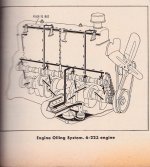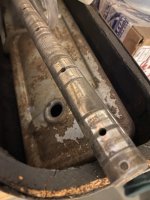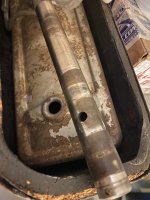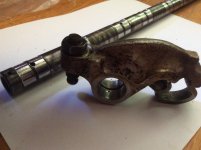Good to read that you got your head back with upgraded hardened seats. My 59 223 six is original. My late dad bought it new in Southern California. It has a retrofitted PCV Valve per California Smog mandate in 1966. The 223 six is one durable engine. Mine has over 228,000 miles on it with no overhaul, but needs it badly. My late dad and I used Gunk Motorflush every time we changed the oil and filter to clean the sludge buildup before pouring in fresh oil and zinc additive (STP). A rebuilder can rebuild your starter to work with a 12 volt system if you decide to have it upgraded. If it has a generator, it likely got upgraded to a 1956 to 1962 12 volt electrical system.
Thank you sir, So after a week or so of research, I found that b2az-6065a is I think the original part # for the pre 61 head bolts, they were 7/16, later head bolts were 1/2" not sure part #, maybe the one you have.
So the head that I have uses 1/2" head bolts and the block has 7/16" threads. Ford made bolts to put the new head on the old block. They are called shoulder bolts and have 1/2 shoulder annld 7/16" thread. Ford part# D3NN-6065-A. This is also an ag part for tractors, not many of them left. I found one for $44 and a set of four for $129 NOS. I scored the set of four for $75. I'll probably just use these 4 to line up the head and use cheaper 7/16" bolts for the rest.
Ford also made a stud to go the other way. !/2" threads on bottom & 7/16" shank 4" long. Then you put nuts on the top. Ford part# D3NN-6N014-A
Man... See I thought I was just about to throw this thing together and you tell me this...A bit late to the party but those tubes are the OEM oil sending and return lines. The rear one (input) has the O ring seal the forward one (return) has no seal at the bottom. If you have not already I would suggest pulling out the cotter pin at one end of the rocker tube so you can remove a rocker and check the shaft for wear. Virtually all the wear occurs on the bottom half of the shaft....you can't see it till you pull one off though you may feel it if you can move the rocker up and down a small amount on the shaft. Photo shows the forward rocker removed and notice the wear on the shaft. I found some of the oil delivery holes to be partial plugged with oil sludge. The bushings in the rockers did not show as much wear visually and fit good on the non-worn area of the shaft. After much searching I did find an complete OEM re-manufactured assembly at Green Sales and after I put the word out a this and one other forum their stock of 11 quickly sold out. Mine is the later zero lash rockers while yours is the earlier version. There are soft metal plugs in each end of the shaft and you could pull these out for cleaning...as long as you have replacements in hand.....I have seen these available. If you need a new shaft you are going to have a search on your hands but I think the earlier rocker version is more common than the zero lash.
The head in it's entirety apparently was in good shape per the machine shop. His only concern was the valves being the ones used with leaded fuel. So I assume the head had never been rebuilt. And given it's condition, probably very little wear. However now I want to take it apart and see the wear on the rockers for myself




